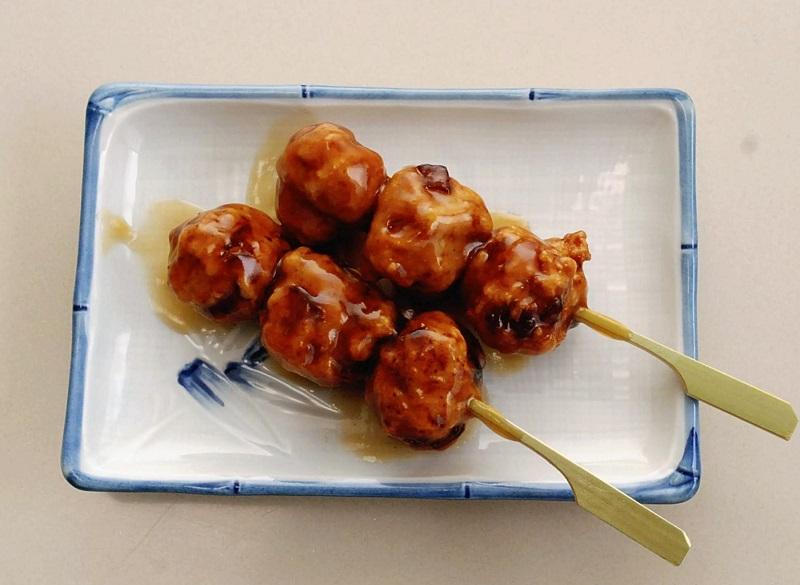What does giant salamander taste like?

Skewered meatballs that re-create the taste and texture of Japanese giant salamander | The Yomiuri Shimbun
MANIWA, Okayama — Japanese giant salamanders, despite being designated as a Special Natural Monument, are being served up at dining tables, in a manner of speaking. A dish that recreates the taste of the giant amphibian is currently being sold in the Hiruzen district of Maniwa, Okayama Prefecture.
Students of Katsuyama High School, which has a campus in Hiruzen, recently developed the dish as part of a school project about the giant salamander, which lives in the Hiruzen Highlands.
“Hanzaki,” as the locals call the creature, is known as a symbol of longevity because of a legend that states it can stay alive even if cut in half. Until shortly after World War II, it was eaten in Hiruzen as a valuable source of protein in miso soup and other dishes, like hot pot. But today, it is prohibited by law to catch or keep them.
Six third-year students at the high school were given a school project to research the relationship between people and the salamanders. While doing their research, they became fascinated with the idea of what the giant salamander tasted like. And so they decided to create a recipe to answer that question.
Through interviews with local elderly people who had eaten giant salamanders before it was illegal, they learned that it had a mild flavor and crunchy texture.
Article continues after this advertisementWith the help of Isao Oiwa, a coordinator for community education, the students recreated the meat in the style of both the interviewees and the students’ favorite dish: hamburger steak. The comment about a “mild flavor” made the students think of chicken, so they used it as a base for the patties. They tossed chicken cartilage mixed in a blender to add crunchiness. In addition, they used chopped onion, eggs, and potato starch. And finally, the giant salamander was said to have a faint smell of Japanese pepper, or sansho, so the spice was kneaded into the patties as well.
Article continues after this advertisementThe dish is called “Hitokuchi Uo Uo Hambagu,” (bite-size fish and fish hamburger steak). Local people are excited about the birth of the new local dish in addition to the current one, Hiruzen Yakisoba, miso-flavored stir-fried noodles.
The meatball-sized dish is easy to eat and reheat. Since some of the elderly interviewees mentioned that they would use giant salamander in sukiyaki, a type of hot pot dish, the students decided to coat it with a sweet and salty sauce made of soy sauce, mirin cooking rice wine, and ketchup.
Ryuji Goto, the owner of local restaurant Kogentei, now offers the dish. He is a graduate of the students’ school from before it changed to its current name. After being asked if he would add the dish to his restaurant’s menu, he agreed in order to support the students.
“It’s delicious, and the decision to add sansho is a novel idea,” Goto said. “I think that it not only pairs well with sake and other food, but it can also become a great souvenir.”
Two students who helped create the recipe attended a tasting event in mid-March. Misato Sugimura happily said: “We came up with the idea to skewer the meat because we thought it would be easier to eat that way. I’m so happy that it’s on the menu.”
Ikumi Miyamoto added: “I never thought it would be served at a restaurant. I want it to become a Hiruzen specialty, alongside Hiruzen Yakisoba.”
One skewer with three pieces costs ¥250. Give it a try if you’re in the area!

Misato Sugimura, center, and Ikumi Miyamoto, right, speak with Ryuji Goto, who serves a dish based on their recipe at his restaurant. | The Yomiuri Shimbun
RELATED STORIES
A cave salamander didn’t move from the same spot for 7 years, new study finds
Why some animals are more loved than others
Nuns get hands dirty and wet to save Mexico’s salamanders